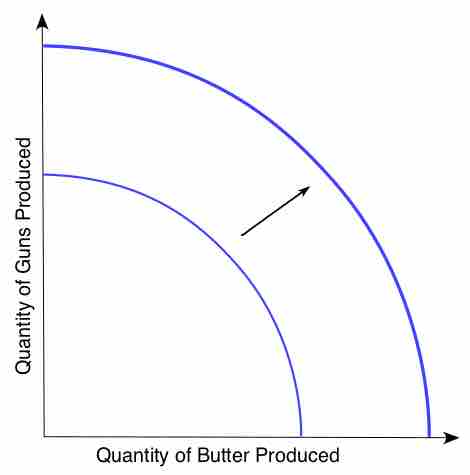Economic growth can be defined as the increase in real gross domestic product (GDP) in the long-run, or as increased productivity or via an increase in the natural resources (inputs) that create output. It is important to note that real GDP adjusts for inflation, rather than looking at output in nominal dollars. Economic growth could also be described as an outward shift in the production-possibility frontier, allowing for the production of a higher quantity of goods (see ).

Production-Possibility Frontier
This outward shift in the Production-Possibility frontier is indicative of economic growth within the economy it represents.
Standard Measures of Economic Growth
Measuring economic growth is reasonably straight-forward, primarily focusing on either increases in productivity or increases in the available production inputs in a given system. This increase in productivity is converted into a relative percent based upon previous years, and expressed as a growth or decline. For example, if a given economy is producing $1,000,000 in 1900 and 1,050,000 in 1901, the economic growth rate (or GDP growth) will be expressed as 5%. If inflation is calculated to be 3% between 1900 and 1901, real economic growth will equate to 2%.
Alternative Economic Growth Models
While measuring real GDP is useful in some ways, and considered a standard measure of economic growth, there is a great deal more complexity than is being captured (both quantitatively and qualitatively). An outline of the perspectives of economic growth over time include:
- Classical Growth Theory: Dating back to Adam Smith and the foundation of capitalism, classical growth theory uses the production function to measure economic growth.
$Y=f(K,L,N)$ , where Y, K, L and N represent output, capital, labor and land respectively. In this model, the overall growth of an economy will compound exponentially and capture economies of scale, implying that economic expansion via consistent growth is a reasonable proposition. - Growth Accounting: Growth accounting came into popularity after the classical model, identifying the crucial role of technology in economic growth. Using the same classical growth equation, this method of measuring economic growth replaces the 'land' variable with 'technology' (technology including all of the contextual components that enable growth). In this scenario, technological leaps and bounds can be captured in the overall growth model.
- Salter Cycle: Economic growth is ultimately enabled by increases in productivity, and thus reductions in the required inputs to achieve each subsequent output per unit. As a result, an economy will continuously decrease price and thus increase demand, minimizing marginal utility over time and saturating markets.
- Endogenous Growth Model: This model takes into account technology, as in the growth accounting system discussed above, alongside increases in skills and intellectual capital. A more educated workforce will result in increases in real output, as will advances in technology and innovation.
- Energy Growth Theory: There has been a consistent correlation between economic growth and energy increase, alongside a paradox that increased energy and resource utilization efficiency actually increases consumption of that resource (similar to the Salter Cycle concept). As a result, energy growth theory economists identify a critical role of energy and resources in measuring overall economic growth.